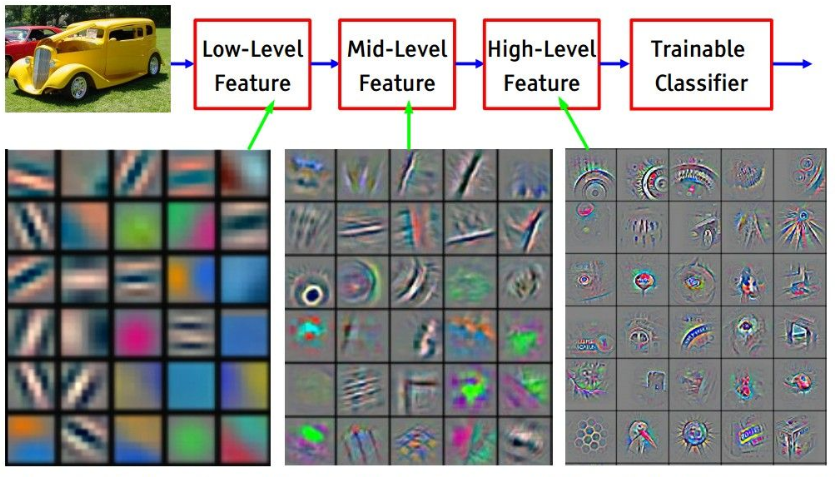2023-Q3-AI 5. Image classification - ConvNet ResNet
5.1. Video / Materials
Video: https://youtube.com/live/nVY2l0CWN6Y?feature=share
Jamboard: https://jamboard.google.com/d/1Hwx0VZ7OKecyJnUps0d-CZXKiR5vFPTsg4Fe7-DMgEA/edit?usp=sharing
Materials: https://cs231n.github.io/convolutional-networks/ http://www.cs.utoronto.ca/~rgrosse/cacm2011-cdbn.pdf https://ikhlestov.github.io/pages/machine-learning/convolutions-types/ https://github.com/vdumoulin/conv_arithmetic/blob/master/README.md
ResNet: https://arxiv.org/abs/1512.03385
DenseNet: https://arxiv.org/abs/1608.06993
Ir iedota pieeja jamboard un ar OBS jāveic screen streaming uz šādu setting
OBS key: s29p-6tk6-hyq3-uueu-0hvf
Par katru uzdevumu dodam 100 punktus
5.2. Implement the Conv2D kernel function
Implement Conv2D without using the built-in PyTorch version, following the instructions from the video.
Submit the code and a screenshot with the best results.
Template:
http://share.yellowrobot.xyz/quick/2023-2-27-7FA5DF91-9B41-4E56-8630-485CCA078E45.zip
5.3. Implement ResBlock according to the scheme
Implement ResBlock according to the scheme, this time using the built-in PyTorch ConvNet2d class.
Submit the code and a screenshot with the best results.
Template:
http://share.yellowrobot.xyz/quick/2023-3-5-746B40C5-AD38-4ABC-B0EB-88664531AC55.zip
Scheme:
http://share.yellowrobot.xyz/upic/a65c781c39c912ce3f6eb0fa0d8683d2_1648487642.png
5.4. Implement DenseBlock according to the scheme
Implement DenseBlock according to the scheme:
http://share.yellowrobot.xyz/upic/78a04509453a172cc8e9f4596e3f1bfb_1648487642.png
Concat torch across the channel dimension: out = torch.cat([x, conv1, conv2], dim=1)
Submit the code and a screenshot with the best results.
5.5. Implement Transition Layer according to the scheme
Implement Transition Layer according to the scheme:
http://share.yellowrobot.xyz/upic/818ebd4aefaaac1b89a95a001b8c2f84_1648487642.png
Submit the code and a screenshot with the best results.
Klases materiāli
Vēl labi materiāli + vizuālizācijas:
https://ikhlestov.github.io/pages/machine-learning/convolutions-types/
https://github.com/vdumoulin/conv_arithmetic/blob/master/README.md
Saturs - ConvNet:
Sākotnēji resursu dēļ izmantoja convnets kā optimizāciju parametru skaitam - Le Cun
Izstāstīt basics datu struktūru image classification task (viņi zina tikai regresiju un klasifikāciju parastiem 1D datiem)
Izstāstīt un implementēt Conv2D kernel function kopā
Ja paspēj var klasē iedot implementēt BatchNorm + izstādīt dažādus norm un pooling
Mājās implementēt ar iebūtvētajām torch functions arhitektūru
Ideāli būtu pamēģināt citu dataset nevis FashionMNIST, piemēram, bet tad jāsagatavo ar download_url_to_file kā 6. sessijā GIT piemērā
Fruits - https://www.kaggle.com/moltean/fruits
100x100
Fish - https://www.kaggle.com/crowww/a-large-scale-fish-dataset
Flowers - https://www.kaggle.com/alxmamaev/flowers-recognition
Olivetti faces - sklearn (1, 64, 64), 40 classes - test 100%
Iepriekšējā gada video par ConvNet
Video: https://youtu.be/xaj1cWtI_BM
Jamboard: https://jamboard.google.com/d/152zSE59rHNV9m-aMhhckM174RiHKdi1RQy_-XSrBN38/edit?usp=sharing
Iepriekšējā gada video par ResNet
Video: https://youtu.be/y9CcSpH1Db4
Jamboard (iedota edit pieeja stefan.dayneko@gmail.com): https://jamboard.google.com/d/1T0k_rnWjj5Flyd0BzJ3-At0QyOth78lfTSkKMdS1Zck/edit?usp=sharing
Saturs - ResNet:
Wanishing gradient problem, training time
Jāizstāsta par ResNet jēgu
Kopīgi jāuzkodē
Jāpastāsta vairāk kā izmantot cuda un kā palaist uz GoogleCollab, jo o aizmirsam pagājušā reizē laikam
pastāstīt par print_model_size
Jāizstāsta par DenseNet jēgu
Kopīgi jāuzkodē
Parādīt kā pārveidot dataset un CCE loss, lai strādātu ar indexes bez One-hot-encoded
Mājās InceptionNet jāiedod - 1000 punkti
⚠️ Iesaku parādīt / pamainīt saturu, lai implementētuj HRNet, RegNet
https://paperswithcode.com/method/hrnet
⚠️ Lūdzu neizmantot __call__ operatoru
xxxxxxxxxx11out = self.conv1(x)Tā vietā izmantot
xxxxxxxxxx11out = self.conv1.forward(x)Citādi studenti nesaprot atsķirību starp member funkciju un member instances funkcijas izsaukumu
⚠️ Lūdzu neraksti objektus / funkcijas bez named params, ja ir hardcoded
xxxxxxxxxx11self.linear = torch.nn.Linear(288, 10)vietā
xxxxxxxxxx11self.linear = torch.nn.Linear(in_features=288, out_features=10)
Jo, tad kods nav saprotams tiem, kas nepārvalda ļoti labi tās funkcijas
Bildes slaidiem
https://www.cs.umd.edu/~tomg/projects/landscapes/

Bioloģiskais pamatojums, bet patiesība optimizācija


http://cs231n.stanford.edu/slides/2018/cs231n_2018_lecture05.pdf












ResNet / DenseNet











